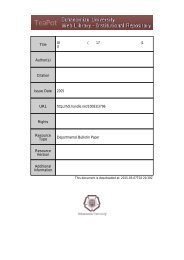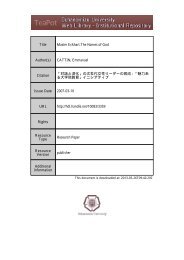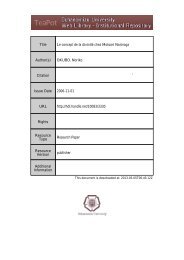View! - TeaPot - お茶の水女子大学
View! - TeaPot - お茶の水女子大学
View! - TeaPot - お茶の水女子大学
Create successful ePaper yourself
Turn your PDF publications into a flip-book with our unique Google optimized e-Paper software.
EZAWA, Mitsuki:Pre-Raphaelitism during the Meiji PeriodDo cultivate your aesthetic taste and makeJapanese tradition develop to a much higherlevel than Heian-Genroku culture in Japan, ormuch higher than the Elizabethan Culture inEngland, or the Medici Culture in Italy. (vol. 3p.49, Underline original, Translation mine)As was clarified by his response to Buchanan criticism,Ueda’s view did not remain as an expressionof nostalgic feeling, nor xenophobic feeling, either.Rather than these, Ueda wished his renaissance toinfluence the artistic development of his country,and what his renaissance expected was the fusionof currently imported foreign culture with traditionalJapanese culture.Then, how did Ueda perform his renaissancepractically? First, he proclaimed the existence ofPre-Raphaelitism in public by the initials P.R.B. asRossetti did in The Girlhood of Mary Virgin in hisfirst stage. In the front page of Ueda’s first translationvolume Miotsukushi (1901/M34), there is adedication as follows:For our memory of the days when we talkedabout P.R.B.,I dedicated this book to my friend TokubokuHirata.How well I remember the days!(vol.2, Translation mine)The title word, Miotsukushi connotes a desperatelove, which Rossetti likes to express, and theliterary source of the word, “miotsukushi” can betraced back to medieval literature, such as TheTale of Genji. 17 And in Miotsukushi, Ueda includedtranslated foreign love stories and his original loveshort story. All of them are written using oldJapanese usage. Therefore, Miotsukushi seems tobe a practice of Ueda’s renaissance.Next, as for Pre-Raphaelite Journal, it should beremembered the existence of the Geien (1902/M35).This journal was edited by Ueda himself after hisdeclaration of P.R.B. Ueda started the memorialfirst number with the appreciation of Rossetti’sEcce Ancilla Domini! In this same number, Hirataalso emphasized the artistic effect of Rossetti’sSt.Ceicily.Finally, as his Pre-Raphaelite achievement,Ueda published his translated volume Kaichoon(The Sound of Sea) in 1905 (M38). This volumeseems to have three significant meanings. First, asUeda makes clear in the preface, this volumefollows Rossetti’s translating method, and exploresaesthetic effects (vol. 1, p.28). Second, in order tofind more suitable expressions, this volume usesthe old Japanese language. Third, this volumecollects three love poems by Rossetti, one poem byDante, and five poems by Baudelaire as if hechallenges Buchanan criticism.However, it was this time that Pre-Raphaelitismin Japan experienced the vicissitudes of the criticism.Kaichoon was published under the martiallaw at the Russo-Japanese War (1904-5), and firstit was appreciated in the Imperial Literature.However, after this number of this volume, thejournal was prohibited from sale, 18 things completelychanged. As if corresponding to a trend forwar worship literature, this aesthetic work wasironically judged militaristic, and forced to be incorporatedinto the literature. As for Ueda’s effort toadopt the old Japanese usage, it was pointed outthat its genteel expressions were unsuitable for theFrench erotic poems such as the poems by Baudelaire,and as if fighting against Ueda’s associationof French culture with the past Japanese culture,the critic emphasized the differences of Japan’spast, with French culture, and insisted on presentJapanese moral superiorities just like Buchanan’s“Fleshly School” criticism. 19Again Ueda tried to raise a challenge againstthis mono-centric nationalistic trend. From Januaryto March in 1910, Ueda contributed his lovenovel, Uzumaki to the newspaper, Kokumin-shinbunn,and published it as a volume in June in the sameyear. The title Uzumaki means “scroll” in Englishand it was one of the last two possible titles togetherwith The Germ. 20 However, Ueda’s Pre-Raphaelitenovel was not understood at all at that time. Notonly by his critics but also by his sympathizers itwas regarded as a failure. 21 It was the same yearthe Great Treason Incident (1910) happened, andin May of this year, Kotoku Shusui (1871-1911),the socialist who opposed the Russo-JapaneseWar (1904-5), was arrested without the proof onsuspicion of the attempt to assassinate the Meijiemperor. This rash action by the governmentsilenced left-wing activists, and in August Japanannexed Korea, and arose as an Empire.* * *In this article, I have proposed that Pre-Raphaelitismis a representation of cultural diversity. DanteGabriel Rossetti, the epicenter of Pre-Raphaelitism,tried to revive the medieval Italian aesthetics inVictorian era. Rossetti’s activities enhanced thecultural diversity in England, and this diversityconflicted with the mono-centric nationalism of the184






